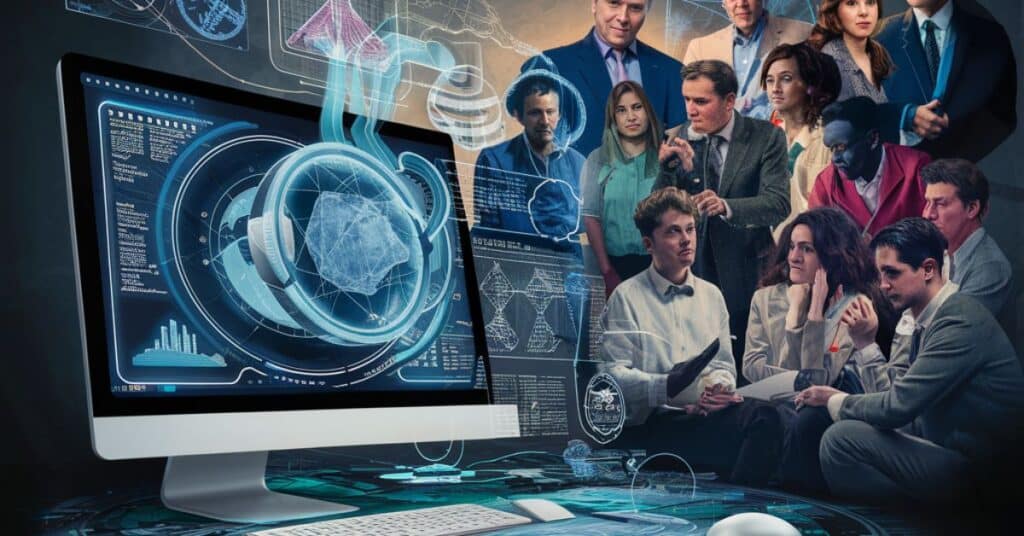Businesses often struggle with foresight. Many fail to see its importance. But why is this Foresight offers valuable insights. Yet, it remains overlooked. Let’s delve into the reasons behind this trend.
Why aren’t businesses embracing foresight it’s a crucial tool for success. Many overlook its benefits. Foresight offers insight into future trends. Let’s explore why it’s not gaining traction. foresight struggles in business due to uncertainty. Many companies focus on immediate needs. They may overlook future planning. Businesses may lack resources for foresight. Emphasizing short-term gains often takes priority.
Introduction to Foresight in Business
In the dynamic world of business, foresight is a crucial tool for navigating uncertainty and driving success. This introduction offers a glimpse into the significance of foresight in shaping strategic decisions and fostering innovation within organizations. By exploring trends, analyzing data, and anticipating future scenarios, businesses can stay agile and seize opportunities for growth and resilience. Foresight empowers companies to adapt to change, anticipate challenges, and chart a course toward long-term success in an ever-evolving marketplace.
What is foresight?
Foresight is like peeking into the future. It’s about predicting what might happen ahead of time. It’s a way to prepare for what’s coming, kind of like looking at a map before starting a journey. Foresight helps us make better decisions today, based on what we think might happen tomorrow.
Think of foresight as a superpower. It lets us see possibilities before they become realities. It’s about being proactive instead of reactive. With foresight, we can anticipate challenges and opportunities, helping us navigate through life with more confidence and success.
Importance of foresight in business strategy
Foresight is crucial in business strategy. It helps anticipate future challenges and opportunities. By looking ahead, businesses can prepare for changes in the market and stay ahead of the competition.
Businesses with foresight can adapt quickly to evolving trends. They make informed decisions that lead to long-term success. Without foresight, businesses may struggle to navigate uncertainties and miss out on valuable opportunities.
Challenges in Implementing Foresight
Implementing foresight poses several challenges. Firstly, obtaining accurate data and predicting future trends accurately can be difficult due to the unpredictable nature of certain variables. Secondly, incorporating foresight into decision-making processes requires organizational buy-in and a cultural shift towards long-term thinking, which can be met with resistance from those accustomed to short-term goals.

Furthermore, coordinating interdisciplinary teams to collaborate effectively in foresight projects can be challenging due to differing perspectives and priorities. Additionally, maintaining the momentum of foresight initiatives over time requires continuous monitoring and adaptation to changing circumstances.
Despite these challenges, embracing foresight methodologies can empower organizations to anticipate and navigate future uncertainties more effectively, ultimately leading to greater resilience and competitive advantage.
Lack of understanding among Traction with Business leaders
Many business leaders struggle to grasp the importance of traction. They may not fully comprehend its value or how it can drive success. This lack of understanding leads to missed opportunities and challenges in achieving business goals. Without a clear understanding of traction, leaders may find themselves unable to effectively implement strategies to propel their businesses forward.
When traction remains elusive to business leaders, it hinders their ability to make informed decisions. Without a solid grasp of traction, they may struggle to identify areas for growth or improvement. This lack of understanding can ultimately impede the overall progress and success of the business. Therefore, it’s crucial for leaders to prioritize gaining a deeper understanding of traction to unlock its full potential for their organizations.
Short-term focus over long-term vision
Many people prioritize short-term gains rather than thinking about the future. They focus on immediate benefits instead of long-term goals. This mindset can lead to missed opportunities and future challenges.
However it’s important to balance short-term needs with long-term vision. While short-term gains may provide quick satisfaction, having a long-term plan ensures sustained success and growth. By considering both perspectives, individuals and businesses can make informed decisions that benefit them in the present while also laying a solid foundation for the future.
Resource constraints
Resource constraints can be challenging. When you don’t have enough resources, it’s tough to get things done. You might not have enough money, time, or people to do what you need. This can slow down projects and make them harder to finish.
But resource constraints also push us to be creative. When we have limited resources, we find new ways to solve problems. We learn to prioritize and make the most out of what we have. It teaches us to be efficient and resilient, finding innovative solutions to overcome limitations.
Misconceptions about Foresight
Misunderstandings about foresight are common. People often confuse it with prediction. Foresight isn’t about foreseeing the future; it’s about preparing for it. Many believe it’s only for business, but it’s useful in various aspects of life. Understanding its true nature is vital.

Some think foresight is solely for experts. However, everyone can develop it. It’s not about having a crystal ball but rather honing analytical skills. By debunking these myths, we can embrace foresight as a tool for navigating uncertainty effectively.
Foresight is not fortune-telling
Foresight isn’t about predicting the future. It’s more like seeing ahead. It helps us plan and prepare. We can make better choices with foresight. fortune-telling is different. It claims to know exactly what will happen. Foresight, though, is about understanding possibilities. It’s about being ready for what might come.
It’s not a one-time exercise
Understanding this isn’t just a single event. It’s a continuous journey. You don’t finish it once and move on. It’s ongoing. Each step leads to another. Keep going, and you’ll see progress. It’s about consistency, not just a one-time effort.
Think of it as a path you walk regularly. Each time, you learn something new. Every effort adds up. It’s not about reaching a destination it’s about the journey itself. So, embrace the process. It’s not a one-time exercise it’s a lifelong commitment.
Foresight doesn’t guarantee success
Having foresight doesn’t always mean you’ll succeed. Even if you can predict what might happen, it’s not a guarantee that things will turn out the way you expect. Life is full of surprises, and sometimes unexpected challenges can arise, no matter how well you plan ahead.
You might have a clear vision of where you want to go and what you want to achieve, but there are always factors beyond your control. External circumstances, changing conditions, and unforeseen events can all impact your journey.
Foresight is valuable, but it’s just one piece of the puzzle. Success often requires adaptability, resilience, and the ability to navigate obstacles as they come your way. So, while having foresight can certainly be helpful, it’s important to remember that it’s not a guarantee of success.
Benefits of Embracing Foresight
Embracing foresight brings many advantages. It helps you plan for the future better. When you use foresight, you can predict potential challenges and opportunities. This helps you make smarter decisions now. Foresight also boosts innovation. By thinking ahead, you can come up with new ideas and solutions. This keeps you ahead of the curve.

Moreover, embracing foresight enhances adaptability. You become more flexible in handling changes. This is crucial in today’s fast-paced world. Additionally, foresight fosters resilience. You can bounce back stronger from setbacks. This resilience is a key trait for success in any endeavor.
Furthermore, embracing foresight leads to improved efficiency. You waste less time and resources by being proactive. This allows you to focus on what truly matters. Additionally, foresight enhances leadership skills. You inspire confidence in others when you can anticipate future trends. This makes you a more effective leader.
Moreover, foresight promotes long-term sustainability. By considering future consequences, you make decisions that benefit both present and future generations. This contributes to a better world for all. In conclusion, embracing foresight offers numerous benefits that empower individuals and organizations to thrive in an ever-changing landscape.
Adaptability to changing market dynamics
In today’s fast-paced market, being adaptable is key. Businesses must change with the market. This means adjusting quickly. Adapting ensures survival. It’s about staying relevant. When market dynamics shift, adaptability is crucial. It’s like navigating rough waters. Those who adapt thrive. They embrace change. This flexibility opens new doors. It allows businesses to seize opportunities. In essence, adaptability is the cornerstone of success in a dynamic market.
To adapt, companies must stay agile. This means being responsive. They must anticipate changes. Adaptability is not just reacting. It’s about proactive measures. Businesses need to read market signals. This helps them stay ahead. Adapting requires a mindset shift. It’s about embracing uncertainty. Companies must be ready to pivot. This means adjusting strategies on the fly. In conclusion, adaptability is not just a skill. It’s a survival tactic in an ever-changing market landscape.
Competitive advantage
Competitive advantage means having something special that makes a business better than its rivals. It’s like having a secret weapon. This could be anything, from lower prices to better quality or faster delivery. Whatever it is, it makes customers choose your business over others.
Businesses fight hard to get a competitive advantage. They might innovate, invest in technology, or train their staff better. Sometimes it’s about finding a unique way to do things. But once you have that advantage, it’s important to keep it. That means staying ahead of the competition, always looking for new ways to improve. In today’s fast-paced world, a competitive advantage can mean the difference between success and failure.
Risk mitigation
Risk mitigation involves identifying, assessing, and reducing potential risks. It’s all about minimizing the impact of unforeseen events. For example, if you’re starting a business, you might analyze possible risks like market competition or economic downturns.
Then, you’d take steps to lessen their effects. This could mean diversifying your products or services, investing in insurance, or creating contingency plans. By addressing risks early on, you can safeguard your venture against potential pitfalls.
Effective risk mitigation is essential for any project or endeavor. It helps prevent costly setbacks and ensures smoother operations. Take construction projects, for instance. Builders face numerous risks, from weather delays to material shortages.
The Role of Technology in Foresight

Technology plays a crucial role in foresight, shaping how we anticipate and prepare for the future.
Enhanced Data Analysis
Technology enables us to gather and analyze vast amounts of data, allowing us to identify patterns and trends that offer insights into potential future scenarios.
Predictive Modeling
Through advanced algorithms and machine learning, technology helps us create predictive models that forecast future outcomes based on current data and trends.
Scenario Planning Tools
Technology provides us with tools for scenario planning, allowing us to simulate various future scenarios and assess their potential impact on different aspects of society.
Collaborative Platforms
Online platforms and collaboration tools facilitate collective foresight efforts, enabling experts from diverse fields to come together, share insights, and collectively envision the future.
Automation and AI
Automation and artificial intelligence streamline foresight processes, helping us analyze data more efficiently and freeing up time for strategic thinking and decision-making.
Emerging Technologies Exploration
Foresight involves exploring emerging technologies and their potential implications for the future, which technology itself enables us to do through research and experimentation.
Read this Blog: HOW LONG IS A BUSINESS DAY?
Future Trends in Foresight
Foresight, or the act of predicting future trends, is becoming increasingly vital in our rapidly changing world. As technology continues to advance at an unprecedented pace, businesses and organizations are turning to foresight methodologies to anticipate upcoming shifts in various industries. These methodologies involve analyzing data, trends, and emerging technologies to make informed decisions about the future direction of their endeavors.
One major trend in foresight is the integration of artificial intelligence (AI) and machine learning algorithms into predictive analytics. These technologies enable companies to sift through vast amounts of data quickly and efficiently, identifying patterns and trends that humans might overlook. Additionally, AI-powered forecasting models can adapt and improve over time, providing more accurate predictions as they learn from new data inputs.
Another emerging trend is the focus on scenario planning and strategic foresight. Instead of relying on single-point forecasts, organizations are exploring multiple possible futures and developing strategies to navigate each scenario effectively. By considering a range of potential outcomes, businesses can better prepare for uncertainty and mitigate risks associated with unexpected events.
In conclusion, future trends in foresight are characterized by the increasing use of AI and machine learning for predictive analytics, as well as a shift towards scenario planning and strategic foresight. By embracing these methodologies, businesses can position themselves to thrive in an uncertain and ever-changing environment.
Advancements in predictive analytics
Predictive analytics has evolved rapidly. It now predicts future outcomes with precision. Businesses rely on it for decision-making. Data analysis drives these predictions. It’s like foreseeing trends before they happen. This technology uses historical data to anticipate future events. Companies use it for various purposes.
For instance, to forecast customer behavior. It helps in inventory management too. Predictive analytics is transforming industries. It enables proactive strategies. Companies can anticipate market shifts. This leads to better planning and resource allocation. As technology advances, predictive analytics will become even more accurate. It’s a powerful tool shaping the future of business.
Integration of AI and machine learning
The merging of AI and machine learning is reshaping industries. AI, a computer’s ability to mimic human intelligence, and machine learning, its ability to learn and improve from data, are revolutionizing how tasks are accomplished. Businesses are integrating AI and machine learning into their operations to enhance efficiency and accuracy.
They’re using AI-powered tools to automate repetitive tasks, analyze vast amounts of data for insights, and make data-driven decisions. From customer service catboats to predictive analytics in healthcare, the integration of AI and machine learning is driving innovation across various sectors. As technology advances, the potential for further integration grows, promising even more profound impacts on society.
Importance of interdisciplinary collaboration.
Interdisciplinary collaboration is crucial. It brings together experts from different fields. These experts share ideas and insights. They work together to solve complex problems. In medicine, for example, doctors, researchers, and engineers collaborate. They develop innovative treatments and technologies. This collaboration leads to breakthroughs.
It improves patient care and outcomes. In education, interdisciplinary collaboration enhances learning. Teachers from various subjects collaborate. They create engaging lessons that connect different topics. This approach helps students see connections. It fosters critical thinking and creativity. Overall, interdisciplinary collaboration drives innovation and progress. It’s essential for addressing today’s challenges effectively.
Frequently Asked Questions
Why is foresight not gaining traction with businesses?
Foresight often lacks immediate tangible results, making it challenging for businesses focused on short-term gains to prioritize.
What hinders the adoption of foresight practices in business?
Limited understanding of future uncertainties and their potential impact inhibits businesses from investing resources in foresight initiatives.
How does the current business culture affect the uptake of foresight strategies?
Many businesses prioritize reactive approaches over proactive ones, favoring immediate problem-solving rather than long-term strategic planning.
What role does risk aversion play in the reluctance to embrace foresight methodologies?
Fear of failure and a preference for maintaining the status quo contribute to hesitancy in experimenting with foresight methods that may involve uncertainty.
What are the consequences of neglecting foresight in business decision-making?
Without foresight, businesses risk being blindsided by emerging trends, disruptive technologies, and unforeseen challenges, potentially leading to missed opportunities and competitive disadvantage.
Conclusion
In conclusion, the limited adoption of foresight practices within businesses stems from various factors. The prevailing culture often prioritizes short-term gains over long-term strategic planning, leading to a reluctance to invest resources in foresight initiatives. Additionally, a lack of understanding of future uncertainties and their potential impact further hinders the uptake of foresight strategies.
Moreover, risk aversion and a preference for maintaining the status quo contribute to the reluctance to embrace foresight methodologies that may involve uncertainty and experimentation. However, neglecting foresight in business decision-making can have significant consequences, including being blindsided by emerging trends, disruptive technologies, and unforeseen challenges.
Therefore, to remain competitive and future-ready, businesses must recognize the importance of foresight, overcome barriers to its adoption, and integrate proactive, forward-thinking approaches into their strategic planning processes.

Alexander K. Barry, an experienced author with five years in business, explores the intricate dynamics of entrepreneurship, management, finance, and innovation through insightful narratives and practical wisdom.







